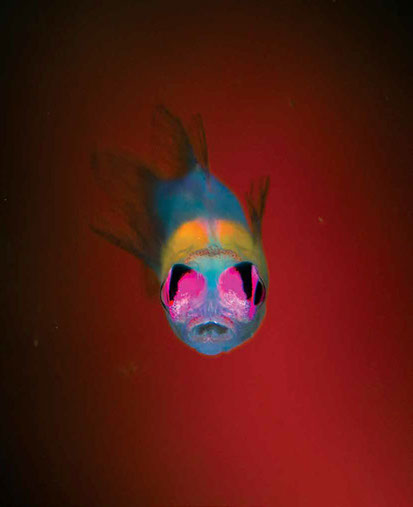
Dive New Zealand | Dive Pacific February 2016
Wakatobi – Beauty is in the Eye of the… Goby
It’s an exercise in patience. Hours spent watching out-of-focus pink orbs flit back and forth across the view-finder screen. Oblivious to anything else except the chill creeping in under the wetsuit and stiffness in the neck and shoulders from holding the camera housing stationary in an awkward position.
Pink-eyed gobies are also known as hovering gobies. Never more than two centimetres long, they cluster in small groups, usually in or near the branches of Acropora coral, and flit about in the current like tiny fireflies, snapping up planktonic specks of food. In constant, erratic motion, they test photographers’ reflexes, and frequently bamboozle the best auto-focus that DSLR manufacturers can offer.
I’d spent five entire dives at 21 metres with this particular group at Wakatobi. The first session yielded some nice profiles, striking enough with the vivid pink eye as the centre of attention, but a couple of glimpses of the fish head-on convinced me that there was more yet to be done. And so began the multi-dive vigil. A half-metre or so beyond the Acropora that these gobies called home, stood a small red finger-sponge. It had cropped up in the background of a couple of the opportunistic shots from the first dive. Totally out of focus because of the hallow depth of field of the extended macro lens, it glowed under the light from the strobes. This offered a better backdrop for displaying the gossamer-thin transparent fins of the goby than plain black.
So hours went by with the camera held as steadily as possible, sponge positioned as the backdrop, hoping that, eventually, one of these little blighters would flit into focus. One did. Once. Wakatobi Resort’s private boat is the ideal platform for this kind of diving.
It’s the closest you can get to diving out of your own boat at home, with the added advantage of having a friendly crew to do all the work, and an expert private guide on-hand to provide detailed local knowledge and locate hard-to-find species.
The addition of this private boat option is another step in the evolution of Wakatobi as a destination. Everybody wins with this evolution. More people get to see and experience the reef-scapes of south-east Sulawesi, and, perhaps gain a greater appreciation for what it takes to conserve ecosystems such as these.
These are reefs that have been fished and exploited for centuries, so they are not pristine. Increasingly large numbers of people live in the vicinity and, in one way or another, depend on the reefs for their livelihood and to feed their kids. But, thanks to Wakatobi Resort’s conservation programme, they are still spectacular reefs. This is conservation based on sound economics. Revenues flowing in to the Resort are creating education and employment opportunities for many locals. These opportunities, in turn, create choice for the local communities: they can choose between unmanaged exploitation of their reefs or sustainable management of them.
So economic growth of the Resort, through its appeal to wider ranges of guests, translates as more opportunity and choice for more local people. In turn, that translates into higher levels of protection for the core assets – the reefs themselves. And that creates more opportunity for divers like you and me to go and stare, if only for a moment, into the hypnotically pink eyes of the hovering goby.
All the photographs we take are made available free of charge for any non-commercial uses related to research, education, or conservation. We routinely share them with whale and cephalopod scientists in various parts of the world. For access to these shots, please click here to contact us.